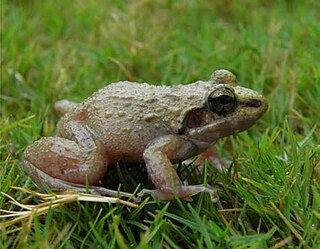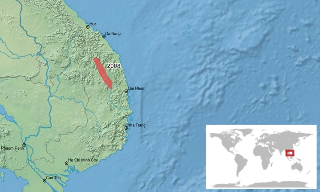
Indirana leithii is a species of frog in the family Ranixalidae. It is endemic to the northern Western Ghats of India. As currently defined, its range is restricted to the states of Maharashtra and southern Gujarat; earlier records elsewhere refer to other species.

Walkerana diplosticta, also known as the spotted leaping frog, Malabar Indian frog, rufous leaf-hopper frog, and Günther's frog, is a species of frog in the family Ranixalidae. It is endemic to the Western Ghats south of the Palghat Gap and only known with certainty from the states of Kerala and Tamil Nadu, India. Localities with confirmed records include the Kalakkad Mundanthurai Tiger Reserve.

Odorrana aureola, also known as the Phu Luang cliff frog or gold-flanked odorous frog, is a true frog species from northeastern Thailand. The specific name aureola is Latin and means ornamented with gold, in reference to the characteristic yellow markings on the limbs and flanks of this frog. It is notable for its ability to change color between green and brown, according to the surroundings.
Oreobates lundbergi is a species of frogs in the family Strabomantidae. It is endemic to central Peru and is known from the Amazonian slopes of the Cordillera Oriental in the Paucartambo District, Pasco.

Leptobrachella tuberosa, also known as the granular toad, is a species of frog in the family Megophryidae. As currently known, it is endemic to the Central Highlands of Vietnam in Gia Lai, Quảng Nam, and Thừa Thiên–Huế Provinces. Its true range is probably wider as suitable habitat extends further north and east, reaching northeastern Cambodia and southeastern Laos. The specific name tuberosa is derived from the Latin tuberosus, meaning "full of protuberances".

Amolops spinapectoralis is a species of frog in the family Ranidae, the "true frogs". It is at present only known from a few locations in central Vietnam—that is, it is endemic to Vietnam—but it is likely to be found more widely in the Vietnamese Central Highlands as well as in the adjacent southeastern Laos and northeastern Cambodia. The specific name spinapectoralis is derived from Latin spina for "thorn" and pectoralis for "of the breast" and refers to the pectoral spines in adult males. Common name spinyback torrent frog has been coined for it.

The Amami tip-nosed frog is a species of frog in the family Ranidae. It is endemic to the Amami Islands, a part of the Ryukyu Islands, Japan. Specifically, it is known from the islands of Amamioshima and Tokunoshima.
Odorrana orba is a species of frog in the family Ranidae. It is found in southeastern Laos and central Vietnam. The specific name orba is Latin for "orphan", referring to the fact that this species was—at the time of species description—known in Vietnam only from a single juvenile.
Philautus abditus is a species of frog in the family Rhacophoridae. It is found in the highlands of central Vietnam as well as in extreme northeastern Cambodia. The specific name abditus is Latin for "hidden" or "concealed" and refers to the black spots on the legs that are concealed while the legs are flexed.
Philautus ingeri is a species of frog in the family Rhacophoridae. It is endemic to northern Borneo and found in Sabah, Sarawak, Brunei, and adjacent northern Kalimantan (Indonesia). Common names Inger's bush frog and Inger's bubble-nest frog have been coined for it. It is named for Robert F. Inger, American zoologist from the Field Museum of Natural History.
Rhacophorus baliogaster, also known as the belly-spotted frog, is a species of frog in the family Rhacophoridae. It is found in the Central Highlands of Vietnam and the Annamite Mountains of adjacent Laos. Its range probably extends into eastern Cambodia where suitable habitat should be present. The specific name baliogaster is derived from the Greek words balios and gaster, meaning "spotted or dappled belly".
Rhacophorus exechopygus is a species of frog in the family Rhacophoridae. It is found in the Central Highlands of Vietnam and in the adjacent Annamite Range in Laos. Its range may extend into northeastern Cambodia where suitable habitat should be present. The specific name exechopygus is derived from the Greek words exechos and pygos (=buttocks), referring to the infra-anal projection characteristic of this frog. Its common names are spinybottom tree frog and Tramlap flying tree frog.
Leptomantis gauni is a species of frog in the family Rhacophoridae. It is endemic to Borneo and is found in Sabah and central Sarawak (Malaysia), Brunei, and north-eastern Kalimantan (Indonesia). The specific name gauni honours Gaun Sureng, a collector for the Sarawak Museum and a companion to Robert F. Inger on field trips when this species was observed. Common names short-nosed tree frog and Inger's flying frog have been coined for it.
Papurana milneana is a species of "true frog", family Ranidae. It is endemic to Papua New Guinea where it is found in the upland areas of Milne Bay, Morobe, Northern, and Central Provinces, as well from the D'Entrecasteaux Islands and, tentatively, Louisiade Archipelago. It was originally described as a subspecies of Rana grisea, but raised to full-species status in 2007.
Chalcorana rufipes is a species of "true frog" in the family Ranidae. It is endemic to Sumatra, Indonesia. It was split off from Chalcorana chalconota by Robert Inger and colleagues in 2009, along with a number of other species. The specific name rufipes is derived from Latin rufus meaning reddish and pes meaning foot, in reference to the reddish tinge on the underside of the pedal webbing in life.
Papurana supragrisea is a species of true frog, family Ranidae. It is endemic to New Guinea, including some nearby islands. It is known with certainty only from southeastern New Guinea and from the D'Entrecasteaux Islands. However, this name has been used more broadly for a species complex that is widely distributed in the mountains of New Guinea. Common name Papua gray frog has been coined for it.
Theloderma palliatum is a species of frog in the family Rhacophoridae. It is endemic to Vietnam and so far only known from the Bidoup Núi Bà and Chư Yang Sin National Parks. This species, together with Theloderma nebulosum, was first found by Australian and Vietnamese scientists in Tay Nguyen in 2011.
Rhacophorus robertingeri is a species of frogs in the family Rhacophoridae endemic to Vietnam. First found in the Annamite Mountains of Vietnam, it is now known from mountain areas between Hà Giang or Nghệ An Province in the north and Gia Lai or Bình Thuận Province in the south, depending on the source. This species can be differentiated from its congeners based on the pointed projection at the tibiotarsal articulation, as well as coloration.
Gracixalus trieng, also known as the Trieng tree frog or Trieng bushfrog, is a species of frog in the family Rhacophoridae. It is endemic to Vietnam and is only known from the area of its type locality, Ngoc Linh Nature Reserve in Đắk Glei District, Kon Tum Province. Mount Ngoc Linh and adjacent peaks form an isolated high-elevation area and the species is unlikely to exist elsewhere.
Pelophryne saravacensis, also known as Sarawak dwarf toad, is a species of toad in the family Bufonidae. It is endemic to Borneo and only known from Sarawak ; there are records from at least four localities representing three different divisions.






